Saturday, July 21st 2012
The day started in some disarray as I had had a largely sleepless night and then, when I did get to sleep, the alarm went off an hour early. I was already up and doing before I realized this but then I went back to bed where I slept for 50 minutes or so and awoke feeling I needed to sleep on for a week. Nonetheless, I got up and continued the usual transactions (feed cat, wash dishes, wash self, get dressed…) and, a little blearier-eyed than usual, we set out, more or less at the time planned.

Faversham Station
We arrived to rain
At this point we had no idea where we were going so we headed for King’s Cross and St Pancras, looking for somewhere where we could have breakfast and where there would be WiFi so that Tigger could look up maps, routes, and train times on her iPod. At St Pancras Station, we found Pret a Manger open and had breakfast there. Breakfast eaten, scanning done and a destination emerged: Faversham!
The last time we visited Faversham, it was by accident (see Accidentally in Faversham), and we had been thinking it was high time we went back there on purpose.
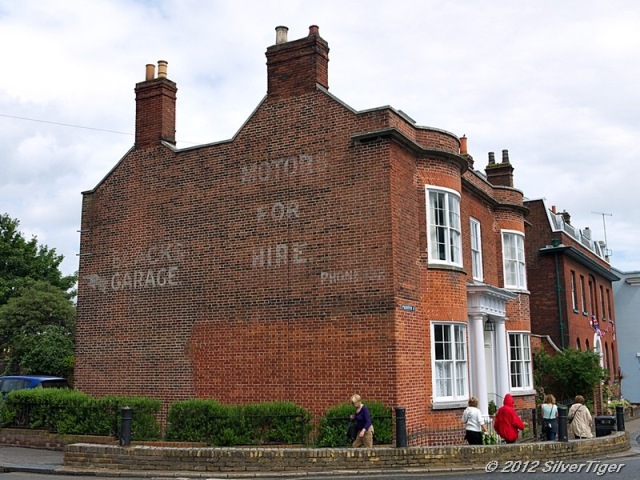
“Ghost sign”
Advertising Black’s Garage
When we left London (aboard the 9:55 HS1), the weather was promising. During the journey, though, the clouds gathered and we stepped off the train into rain. However, the rain soon passed and the day gradually brightened. The day became sunny and warm and it felt like the first day of summer.

Queen’s Hall
Originally the parish hall for St Mary of Charity (1903)
We walked towards the town centre by a roundabout way, following whichever route seemed to offer interesting things to see.
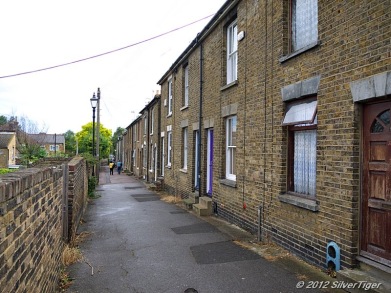

Dorset Place
One house has goods for sale
We passed along this lane of houses called Dorset Place. I don’t know for sure how old they are but the design of the boot scrapers suggests they are Victorian. One of the houses had turned a front window into a display for selling goods, including vegetables and jam. I guess these are home grown and home made.
I liked this house on the corner of Stone Street and Roman Road, with its patterned window glass on the front door and the terra cotta decorations.

Faversham Almshouses
Built 1863, modernized 1982
Just across the road, this fine large building is set in beautiful grounds. It contains Faversham Almshouses and was built in 1863 with money from a bequest of Henry Wreight, sometime mayor of Faversham, and replaced a number of smaller groups of almshouses scattered around the town.
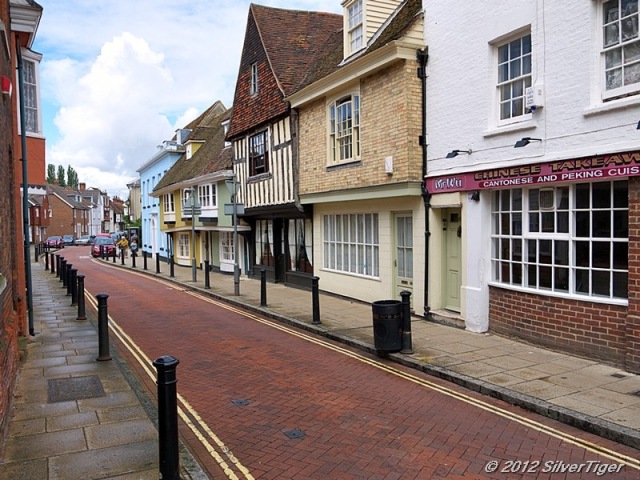
West Street
Houses in many styles and of different ages
One of the charms of Faversham is the amazing variety of houses and other buildings that it contains. They are of different ages – some very ancient – and different styles. Some are better preserved than others and some show signs of a chequered career. As a collection, though, they make an intriguing display.
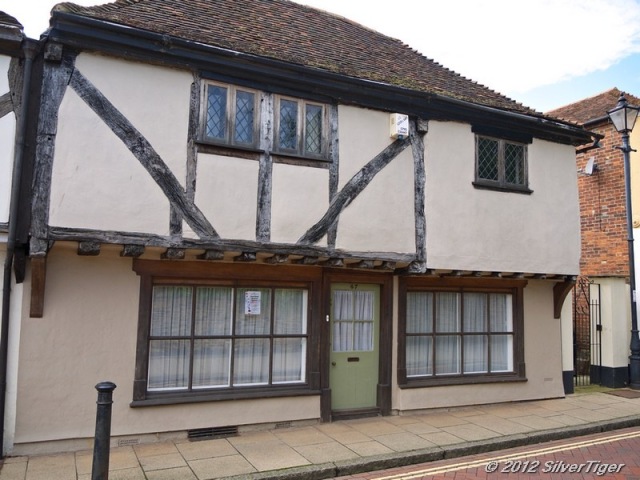
Tudor house
We were invited to see inside
We were photographing this fine old house when the owner came along and we got talking. He was kind enough to invite us to see inside. The house is of unusual design, the rooms not being in the positions that would normally be expected. This has been put down to the house having been occupied by a craftsman who used the front of the house as his workshop and the rear for accommodation. Restoration has been an ongoing activity for many years and has brought the reward of a beautiful result. As well as a house that its present occupants can enjoy, an architectural treasure has been preserved for future generations.
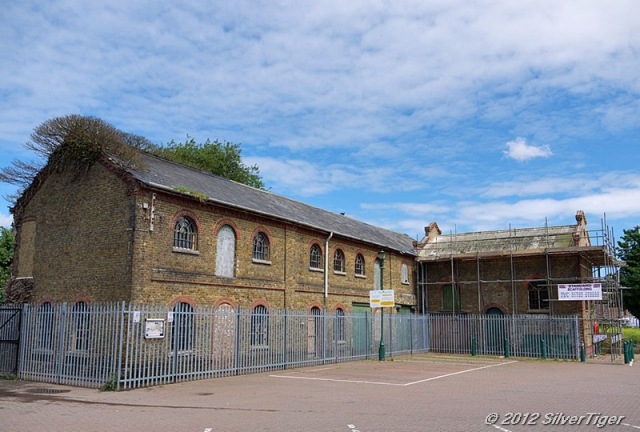
The Purifier Building
To be the centre for Faversham’s shipwright apprenticeship scheme
From this gentleman we also learned about the existence of the Faversham Creek Trust which, in its own words, is “working to rebuild the Maritime Heritage of the Creek”. One of its current projects is to reclaim and restore the rather impressive Purifier Building – part of the old gas works now replaced by a Morrison’s supermarket – which will, when the work is completed, enable to people to learn the skills of shipbuilding which was once an important part of the town’s activity.

The Creek
Once a busy commercial waterway
The Creek, deriving from the River Swale, penetrates to the heart of Faversham both physically and symbolically. It is lined with quays, and ships once came here to offload and take on cargoes. There was also a shipbuilding industry. Today, the waterside was all the more colourful because of the craft that had come to join in the two-day Faversham Nautical Festival.
We visited the quays on our first trip but today the scene was particularly animated because of the festival. There were stalls offering food and refreshments and live entertainment, and various local organizations were represented, including the Faversham Creek Trust.

Steamboat ‘Barking’
Built in Faversham in 1928
Drawn by the smell of coal smoke, I discovered this fine small steamboat, the Barking, built at Faversham in 1928 and still going strong.

Town Warehouse
Also known as TS Hazard
Nor would you want to miss the historically interesting and extremely photogenic town warehouse, built in 1475 to accommodate the goods being unloaded at the quays from the incoming ships. Today it is the headquarters of the local Sea Cadets and is known as TS Hazard, the name of the ship proudly supplied by Faversham in 1588 to join the fleet against the Spanish Armada.

Shepherd Neame Brewery
Brewing beer since 1698
Not far away is the massive presence of Faversham’s very own brewery which bears the famous and respected name of Shepherd Neame. Just walking around the perimeter gives an impression of the size and complexity of the site which, I guess, has an intriguing history of its own.

Abbey Street
A showcase of historic buildings still serving their purpose
We continued on our way, exploring as we usually do, following our noses along whatever routes seemed to offer sights worth seeing. We crossed the end of Abbey Street, full of beautiful historic houses, lovingly restored. The plaque tells us that it is “ONE OF BRITAIN’S FINEST MEDIEVAL STREETS. SAVED FROM DESTRUCTION AND RESTORED IN 1958.”

16th- or 17th-century?
Experts seem to disagree
We had already “done” Abbey Street on our previous visit so this time we left it aside and continued along Court Street. Faversham is one of those towns where you have to keep a steady nerve or risk feeling overwhelmed by the sheer number and quality of the beautiful old houses. Like this one, for example, on the corner of Court Street. National Heritage says it is “early C16 refronted in C18” but another source suggests that it is later than that, more like early 17th-century. Leaving the experts to argue among themselves, I will admire and photograph the house and move quietly along.

Market stalls
Court Street, not yet Market Square
We were heading towards Market Square but we already encountered market stalls in Court Street, presenting a lively display, especially now that the sun was shining brightly, picking out the colours. Faversham is an ancient market town and the tradition is surviving well.
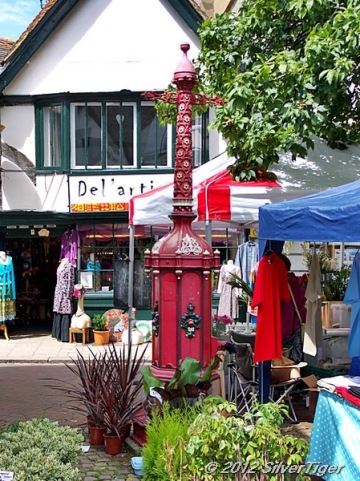
Town pump
An unusually colourful example (mid-19th-century)
I was hoping against hope to get a picture of Faversham’s unusually colourful mid-19th-century town pump though I know that on market days it tends to be hidden by stalls and displays – as it was again today. The trick is to come back after the market has closed. (Here is a picture taken on our previous visit.) Faversham has had a market since ancient times and whereas most towns these days feel lucky to maintain a weekly market, Faversham manages no less than three (on Tuesday, Friday and Saturday).

Guildhall
Originally the Market Hall (1574)
Market Square is also where we find the Guildhall, the seat of local government. The building was not originally intended for this purpose, having been built in 1574 as the Market Hall: inclusion of the open ground floor, intended to provide cover for market stalls, gives the game away. However, the corporation, having tried out two other accommodations and not found them to its liking, took over the Market Hall for that purpose in 1603. There was something of a contretemps in 1814 when the building was set on fire and damaged – apparently by unruly folk as a way of celebrating one of Wellington’s victories in the Napoleonic war. The Guildhall was repaired and slightly enlarged and continues maintaining a robust presence up to the present day.

West Street
A pleasant shopping area
We continued into West Street, a pleasant street of shops of all kinds. Here too we saw the smallest coffee outlet that I have ever seen!
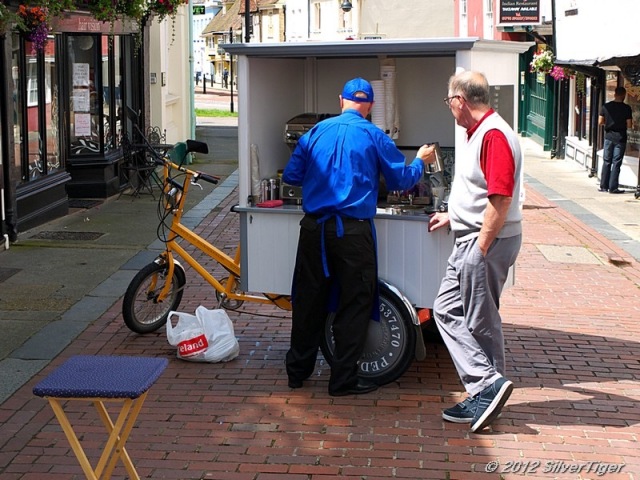
Is this the smallest coffee shop?
Driven by pedal power
It is called, reasonably enough, “The Mobile Coffee Shop”, as it is driven by pedal power. Small it is, though complete in every detail, as far as I could see. There was a stool associated with the coffee shop but I think this was for staff, not for customers. The business model is strictly take-away.
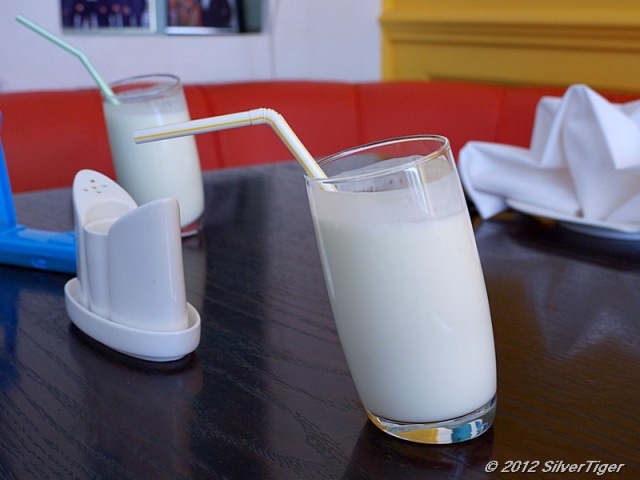
Lassi
The glasses are wonky. It’s not your eyes
We now began to feel peckish as it had been some time and quite a few miles since breakfast. We started crisscrossing the town looking for an eatery that would serve interesting vegetarian dishes and wouldn’t be crowded. In Preston Street we came upon the Spice Lounge. We had a good and filling Indian lunch, laced with lassi. This was served in wonky glasses, as you can see.
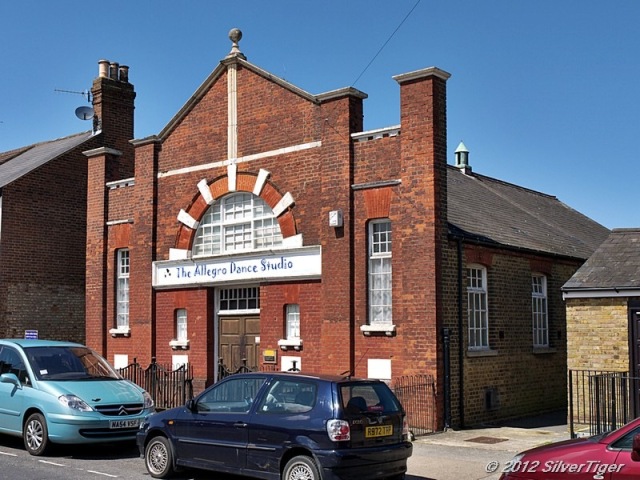
Chapel or Church Hall?
Now a dance studio
By now, the clouds and rain of the morning were a distant memory, and the conditions were sunny and warm – almost uncomfortably warm. We debated what to do and the choices seemed to be go on a bus ride or sit out the heat in a tea room or pub or coffee house. We decided to try a bus ride and stood for some time at a bus stop in Stone Street, opposite the building pictured above. This has not one but four foundation stones, all dated November 1906. But what was it – a chapel or a church hall? There are no clues, though I have noticed before that buildings with several foundation stones have often been built by small religious groups in need of the place of worship.
After a while, having tried this bus stop and another one, we gave up on the bus ride idea because, either the buses were not going anywhere interesting or if they were, that service didn’t run on a Sunday.

The Leading Edge
A rough pub? Surely not?
So we sought a rest and a refuge from the heat in the Leading Edge, a pub we had visited the last time we came to Faversham. It seems a pleasant enough pub and well run. On the previous occasion, we mentioned this pub to a local who opined that it was sometimes rough. That somehow seems unlikely. Was he perhaps trying to impress two Londoners?


Ornate doorway
With beautiful decorative glass work
We began to work our way slowly back to the station, “slowly” because there were things to see and admire at every turn, as, for example, the above ornate doorway with beautiful glass work, belonging to a Victorian era house in Newton Road.


Before and after
Two Edwardian houses (1908)
Across the road were two Edwardian houses with the date “1908” on their lintels. I was photographing them both as a sort of “Before-After” pair. (To be honest, I prefer the one of the right which looks more “lived in”.)
This is where we encountered what I call the “Faversham Effect”: a passer-by, seeing what I was photographing, stopped and exclaimed “Hasn’t he made a good job of the house!” The inhabitants of Faversham love their town and are proud of it. What is good about this is that they are welcoming of anyone who shows interest in the town. In some places we have visited, photographers are treated with suspicion, as if the neighbours think we are casing the joint. Not in Faversham, though. If you show enthusiasm for their town, they are delighted and ready to tell you all about it. Such conversations enhance your enjoyment of your visit.
We shall certainly return to Faversham for further visits.
Here is a collection of decorative figures seen around Faversham. If you are yourself from Faversham, you might like to amuse yourself remembering or guessing where they are to be found.
Copyright © 2012 SilverTiger, https://tigergrowl.wordpress.com, All rights reserved.



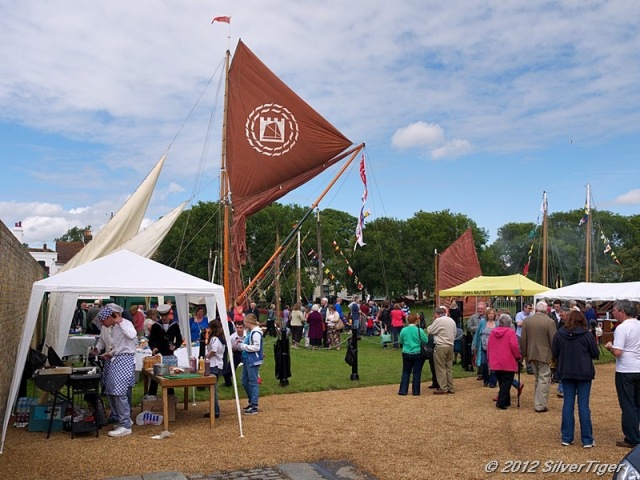

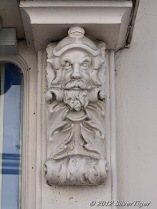
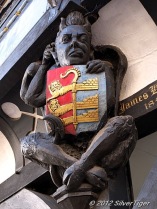
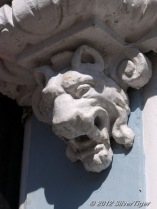


The house with the ghost sign is a pretty little thing. Nice little Georgian number. When could I move in, do you think? In addition to wonky glasses, the Spice Lounge has interesting salt and pepper sets. The stained glass on the Barty House door is pretty enough from the outside, but from the inside, it must be glorious on a sunny day. As for your “before and after” pair of houses, the lack of window curtains on the left-hand ones, and what looks to be a bed sheet over the ground floor window suggests it may be between inhabitants or in the process of refurbishment. There is a certain similarity between the style of architecture to the point that it looks as if the same floor plan may have been used for both except one layout is the mirror image of the other.
LikeLike
It’s quite common in England to build a row of houses in mirror-image pairs to make “semi-detached” houses (a step up from terrace houses but not yet completely “detached”). Even terrace houses which are all joined together in a row are often arranged in mirror-image pairs.
LikeLike
Great blog about your visit to Faversham and I particularly liked your comment about the Faversham effect! I’ve tweeted a link to your blog from http://www.twitter.com/abbeychapel and if you’d like to move here check out our website http://www.abbeychapel.com
LikeLike
Thanks but house prices in Faversham are too rich for our purse.
LikeLike
Splendid photographs!
LikeLike
Thank you. Glad you like them. I’ll come back and take some more another day 🙂
LikeLike
Soooooooo jealous that you can just hop on a train and enjoy such delights!
LikeLike
Yes, we are very fortunate in that respect.
LikeLike
I came across your blog by accident, and very glad I am. We moved from North London (Hornsey) about eight years ago and love Faversham. A lot of Faversham folk do love their town, and we have lots of events to keep us occupied throughout the year (we were personally at the Nautical Festival at the time of your visit). Our next event is the Carnival this Saturday (13th Oct) and then the Christmas lights. Faversham still has more to offer from what you have discovered so far.
I live on the road where you found the veg in the window and I can confirm that the lady grows this in her allotment and back garden, come Christmas time there will be knitted dolls clothes in the window. The terrace dates from 1863 and originally looked out over fields until the development of Roman, Saxon, Norman and Briton Roads. I understand from one of the neighbours that it was only in the last 20 years that it ceased to be a road and is now mainly a pedestrian route (though some residents do drive up for loading occasionally).
The Allegro Dance studio does have an information plaque on it, I think it says it was a cadet place, but would have to go and read it again. And yes you would have had a fruitless wait at the bus stop – no Sunday buses around here (and they stop very early in the evening as well).
The TS Hazard is our oldest building I think, and it’s named as a ship because inside it is setup to feel like the inside of a ship.
The house that is very clean on Newton Road pictures in your before and after shots, was very dark a couple of years ago and in fact was a rather scary looking dwelling with large bushes and trees in the garden, hence why the new owner took the trouble to clean it.
It is unfortunate but what the local you spoke to said about the Leading Light Weatherspoon pub is true. Being the most affordable pub in Faversham Friday and Saturday nights can be rather ‘rowdy’ inside and just outside (Faversham maybe a lovely country town, but we do have similar undercurrent problems just as anywhere else).
Other parts of Faversham and it’s surrounds that I think are of interest are – the Chart Mills, where you can see an example of a gunpowder mill. Standard Quay at the end of Abbey Street – and a lovely walk along the creek past the boatyard. Brogdale – the National Fruit Reserve. Oare Marshes and bird sanctuary. I could go on. If you would like a guide next time you visit me at contact Jittermugs.
LikeLike
Thanks for the added information. We’ll take note of the destinations you suggest.
LikeLike
Me again, following Julia’s helpful comments. She’s right about treats in store for you on your next visit. I’d add the Museum at the Fleur de Lis Heritage Centre in Preston Street (much bigger than it looks from the outside); the very large parish church of St Mary of Charity (rather off the beaten track), which looks 100% medieval, but ….. you’ll be surprised; Stonebridge Pond at the end of West Street, overlooked by the small Romanesque church of Davington Priory; further afield (long walk!) the Oare Gunpowder Works Country Park (which is no the same as the Chart Gunpowder Mills, which are tucked away in a modern housing estate behind the Almshouses; and, should you be (Roman) Catholic, or even if you’re not, the Church of Our Lady of Mount Carmel, which incorporates the national shrine of St Jude, patron saint of hopeless cases/lost causes. And bear in mind for next summer that on the first three Saturdays in July the Faversham Society runs its Open House event, the longest-established of its kind in the UK.
You buy programme books for each of you at the Heritage Centre for £7.50 or so, and this contains full details of the (usually) around 30 participating properties, most of them listed and not usually open to the public. Too many to see in one day, so if you buy a programme on the first Saturday you can use it again on the second or third.
Someone said property prices are high here. I don’t think they are! One reason maybe why so many people have moved here from inner London suburbs. Sell your house there for £650,000, or whatever, buy the equivalent here for £350,000, and you’ve got money to spend. Only thing is, you need to save money for your season ticket!
Oh, the building you couldn’t identify, which is now the Allegro School of Dancing, was the Salvation Army Citadel.
Best wishes
Arthur
LikeLike
Yes, we are familiar with the Heritage Centre and visited it on our previous visit – see Accidentally in Faversham.
LikeLike
Whoops! Sorry!
LikeLike
Although I didn’t mention it, we did visit the Heritage Centre on this visit, just to buy one or two items in the bookshop.
LikeLike
I found this by accident and I think it’s really interesting but as a faversham born and bred I cringe when I read what you have left out!
Firstly, you need to read into the buildings a bit more, the allegro clearly states it was a Salvation Army hall (which had thriving jumble sales a big band and over a hundred members) at least into the late 1970’s (my grandmother played tambourine there).
You also need to be west again to tanners strata, so named after at least two old tanneries on the site of st Jude’s church there, a popular spot for visiting Catholics to the shrine of st Jude, this building also used to be one of four cinemas in the town and backs onto the stream where you will chart gunpowder mills (open on weekends as a museum).
The oldest building in town is not ts hazard but del Argie on the marketplace that used to be an apothecary, this was built around 1280.
Looking at your other faversham blog I am so happy you loved the museum! It is the dedication of a team of volunteers who make to what it is today.
Wether spoons was not a cinema, however the building next door was as was mackays opposite wether spoons, another cinema was in the victorian building that is in partridge lane opposite the side of the brewery.
You have to come back again and see the hop festival and read more about the houses on the creek, the ship built for the armada in faversham, our royal history ( and lord nelson in the three tuns!) and you have to know of the buildings lost to the horrible 1960’s “improvement”
Including the dolphin hotel in the high street, the large ornate temple building in Newton road, the old station, the brick works, the abbey and old town layout( based on cross lane and other alleys these were the main roads and an be visible in a map, leading to the parish church etc)
Please come back, your photos and enthusiasm are great!
LikeLike
On a short visit to a town like Faversham, one inevitably misses more than one sees. I am not writing a guide book but giving my impression of some of the things I observe.
You could always start a blog, grab your camera and give a systematic account of the town you love.
LikeLike
First, Tigger’s photograph of you taking a photograph is absolutely splendid.
Second, of course you’ve heard from me before – as a ‘follower’ – but I have to agree with all Emma has to say. If you’re interested in some of what’s going on here (and there’s an awful lot, all the time) have a look at the Faversham Society’s monthly Newsletter, past and present issues of which you can see at http://www.faversham.org/community/Faversham_Society/newsletter.aspx
Third, in London have you ever visited what is now called Gresham College, which was once the hall of Barnard’s Inn, opposite what used to be the Pru and is now English Heritage? Not big, but 15th-century, I think.
Arthur in Faversham
LikeLike
Thanks for your appreciation of Tigger’s photo. I will pass it on.
Yes, we have visited Gresham College (and the Pru building on an open day). It’ll be mentioned on the blog somewhere.
When you consider how many places we visit, I think it will be apparent that keeping up with each town individually is not feasible. I am simply recording my impressions and photos, not writing exhaustive guides to individual towns.
I expect that we shall make another guerrilla raid on Faversham one of these days but I cannot commit myself to doing more than scratching the surface here and there.
In my original post, I picked up on the enthusiasm of the citizens of Faversham for their town. Any of these could, individually or collectively, consider composing the blog that Faversham deserves.
LikeLike